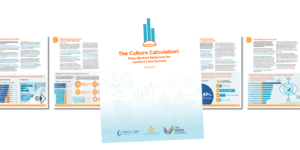October 11, 2023
 NEW ORLEANS, La. — The Contact Lens Institute (CLI), in collaboration with The Vision Council, published “The Culture Calculation: Data-Backed Behaviors for Contact Lens Success.” The free, in-depth guide is the latest in CLI’s “See Tomorrow” research series, and it is designed to help eye care practices enhance their contact lens cultures, in turn increasing patient satisfaction and practice business outcomes.
NEW ORLEANS, La. — The Contact Lens Institute (CLI), in collaboration with The Vision Council, published “The Culture Calculation: Data-Backed Behaviors for Contact Lens Success.” The free, in-depth guide is the latest in CLI’s “See Tomorrow” research series, and it is designed to help eye care practices enhance their contact lens cultures, in turn increasing patient satisfaction and practice business outcomes.
The 19-page, infographic-rich report blends new quantitative research with practical insights and recommendations from forward-thinking optometrists, opticians, and technicians. Its release was timed to the 2023 American Academy of Optometry annual meeting in New Orleans.
“We previewed portions of our culture data at Vision Expo West to tremendous response. Emphasizing the upside potential for speaking with more patients about contact lenses and holistically measuring their value to a practice really struck a chord,” said Stan Rogaski, executive director of the Contact Lens Institute. “The full report goes considerably further, identifying what factors have the most potential to drive a positive contact lens culture both today and over the next three years. Paired with our other ‘See Tomorrow’ projects and consumer data, it offers a customizable roadmap for eye care practices of all sizes.”
When asked which of 21 culture-building factors could make the greatest difference if given more attention or resources, responses were spread across several possibilities. After accounting for product availability, as well as new products and treatments, members of the eye care community focused on items under their direct control: education and training, in-office advocacy, and the emotional and professional benefits of prescribing contact lenses.
Advancements in contact lens products and treatments likewise ranked high among factors that will have the greatest impact through 2026. Profitability as a driver of contact culture is also on the radar for the next three years, identified by 21% of the eye care community as having significant potential. These responses suggest that savvy leaders may devote more energy to keeping their teams and patients informed about contact lens improvements, as well as better evaluating the practice management advantages of contact lens prescribing.
“CLI members appreciate the strong enthusiasm for continued contact lens access and innovation — something the industry has done for decades, with more to come as manufacturers make sizable investments in R&D and production,” said Rogaski. “We are also excited to see the focus on practice management-related culture drivers in the near future. Our findings indicate considerable potential to rethink how contact lens profitability is structured and calculated, and the report offers guidance and perspectives from highly successful colleagues.”
The research also saw respondents overwhelmingly state that online retail presented the greatest perceived threat to contact lens culture. In addition to presenting several components to help practices improve their digital commerce competitiveness, the report includes evidence-based commentary from Alysse Henkel, senior director of Market Research and Analytics for The Vision Council.
She says the organization’s consumer research indicates potential disruption may not be as potent as anticipated: convenience is the primary reason for online contact lens purchases (52%), which is well ahead of price (39%). With online buyers reporting similar spending to in-person buyers, there’s considerable room for confident practices to market their convenience advantages to patients.
Additional guest columns were contributed by several 2023 Contact Lens Institute Visionaries, including: Shelby Brogdon, OD, McFarland Eye Care, Little Rock, Ark.; Andrew Bruce, LDO, ABOM, NCLE-AC, ASB Opticianry Education Services, Vancouver, Wash.; Ariel Cerenzie, OD, FAAO, FSLS, Charlotte Contact Lens Institute*, Charlotte, N.C.; Sabrina Gaan, OD, Eyes on Plainville, Plainville, Mass.; Lisa Hornick, OD, FAAO, Stanford Ranch Optometry, Rocklin, Calif.; Jennifer Lyerly, OD, TrueVision Eye Care, Raleigh, N.C.; Diana Mejia, Bellaire Family Eye Care, Houston, Texas; and Mark Schaeffer, OD, MyEyeDr, Birmingham, Ala.
Data was garnered through a custom-designed survey to The Vision Council’s U.S. Eye Care Provider Panel in August 2023. There were a total of 173 qualified responses, which reflected a mix of optometrists (51%), opticians (35%), and ophthalmologists (5%), with practice managers and owners also included. The survey had a sampling error margin of +/- 6.5% and a 95% confidence rate.
The Contact Lens Institute advances the latest innovations in safe and effective contact lens and lens care products and services that provide unique benefits to patients while satisfying the evolving needs of eye care professionals. CLI undertakes activities that properly assess, enhance, promote and balance contact lens and lens care industry welfare and growth, including the safe use of products in the marketplace. Its members include Alcon, Bausch + Lomb, CooperVision, and Johnson & Johnson Vision.
To read or download “The Culture Calculation,” click here.
* Charlotte Contact Lens Institute is not affiliated with the Contact Lens Institute.













